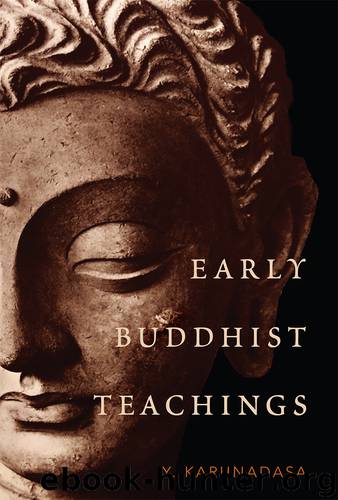Early Buddhist Teachings by Y. Karunadasa

Author:Y. Karunadasa
Language: spa
Format: epub
Publisher: Wisdom Publications
Moral Guidelines
In order to prevent moral evil surfacing at the level of transgression, that is, as vocal and physical acts, Buddhism provides us with a set of moral guidelines. Their purpose is to help us make the right moral decision and to refrain from moral transgressions. One such moral guideline is called self-comparison (attūpamā). Self-comparison invites us to put ourselves in another person’s position and to refrain from inflicting on others what we do not wish inflicted on ourselves. This moral guideline finds expression in the Dhammapada, the Buddhist anthology of ethical verses, in the following form: “All tremble at punishment; all fear death. Comparing oneself to the other, let one refrain from killing others, let one refrain from tormenting others.”15
The same idea is more poignantly expressed in the following quotation from an early Buddhist discourse.
Here a noble disciple reflects thus: “I like to live. I do not like to die. I desire happiness and dislike unhappiness. Suppose someone should kill me. Since I like to live and do not like to die, it would not be pleasing and delightful to me. Suppose I too should kill another who likes to live and does not like to die, who desires happiness and does not desire unhappiness. It would not be pleasing and delightful to the other person either. How could I inflict on another that which is not pleasant and delightful to me?” Having reflected in this manner, he, on his own, refrains from killing and speaks in praise of refraining from killing.16
The quotation demonstrates that the moral guideline of self-comparison also bids that while refraining from killing and from other moral evil, one must also dissuade others from committing the same evils. The quotation further implies that the Buddhist precept relating to abstaining from violence toward any living being is based on the Buddha’s observation that all living beings seek happiness and recoil from suffering.17
Another guideline for moral reasoning is the one based on what is called the “threefold authority” (ādhipateyya).18 Reasoning based on the threefold authority requires us to examine the possible consequences of what we intend to do from three different points of view. The first point of view is called “self-authority” (attādhipateyya). It enjoins us to examine whether what we intend to do would result in self-blame or repentance, that is, whether our own self would censure us for what we have done (attā’ pi attānaṃ upavadati).19 Thus what is called self-authority is a case of allowing ourselves to be controlled by ourselves.
Public authority (lokādhipateyya) is the second point of view. It requires us to examine whether what we are going to do would be censored particularly by the intelligent people in the society. What is called public authority is thus a case of allowing ourselves to be controlled by public opinion. The Buddhist idea of “public opinion” does not exactly correspond to how we understand it today, that is, as the opinion of the majority. For Buddhism, what matters is neither the opinion of the
Download
This site does not store any files on its server. We only index and link to content provided by other sites. Please contact the content providers to delete copyright contents if any and email us, we'll remove relevant links or contents immediately.
The Way of Zen by Alan W. Watts(6460)
Ego Is the Enemy by Ryan Holiday(5241)
The Art of Happiness by The Dalai Lama(4015)
The Book of Joy by Dalai Lama(3863)
Why Buddhism is True by Robert Wright(3378)
Spark Joy by Marie Kondo(3196)
Shift into Freedom by Loch Kelly(3103)
Happiness by Matthieu Ricard(2967)
A Monk's Guide to a Clean House and Mind by Shoukei Matsumoto(2847)
The Lost Art of Good Conversation by Sakyong Mipham(2510)
The Meaning of the Library by unknow(2476)
The Unfettered Mind: Writings from a Zen Master to a Master Swordsman by Takuan Soho(2208)
The Third Eye by T. Lobsang Rampa(2207)
Anthology by T J(2129)
Red Shambhala by Andrei Znamenski(2123)
The Diamond Cutter by Geshe Michael Roach(1999)
Thoughts Without A Thinker: Psychotherapy from a Buddhist Perspective by Epstein Mark(1944)
Twilight of Idols and Anti-Christ by Friedrich Nietzsche(1811)
Advice Not Given by Mark Epstein(1800)
